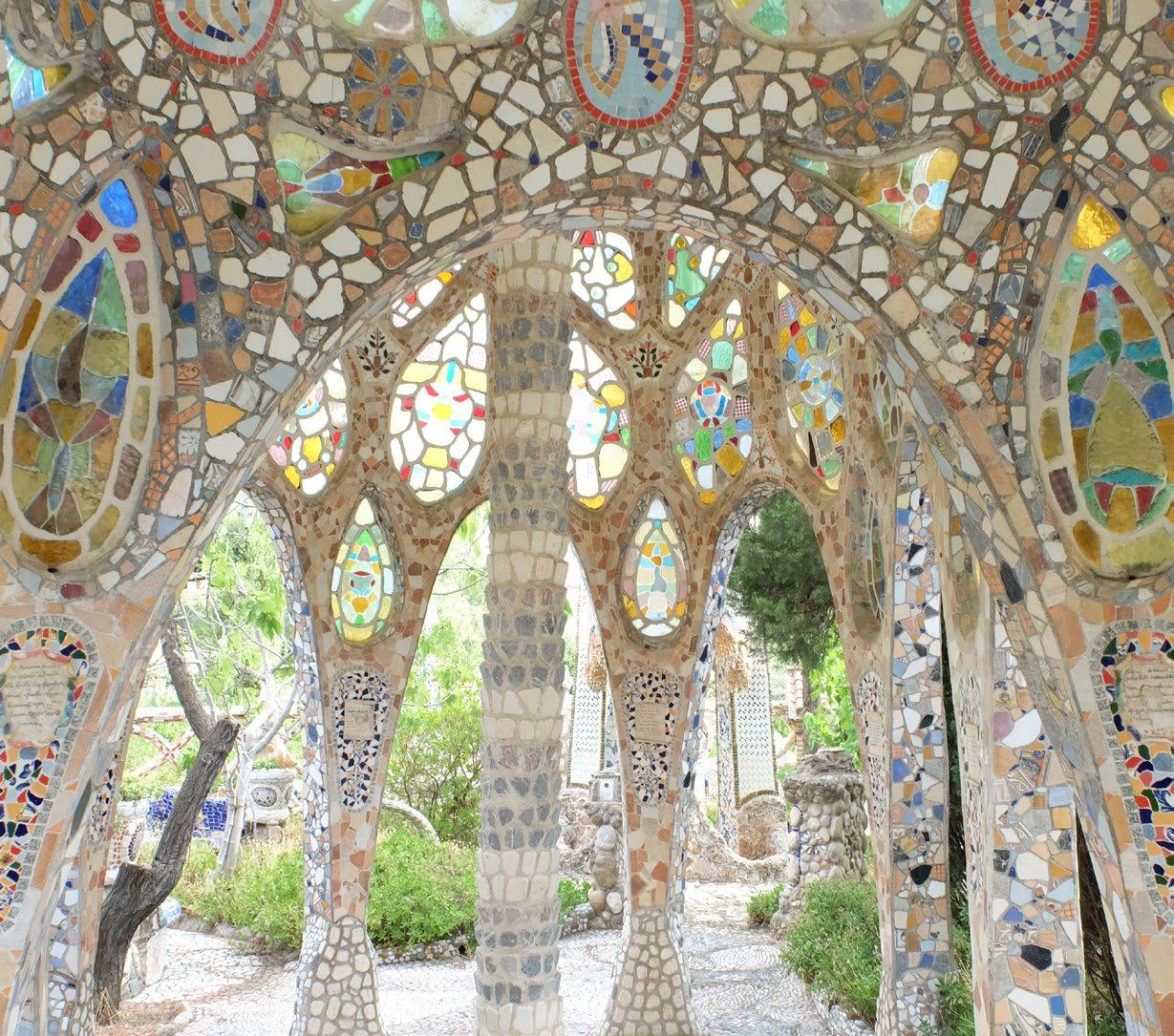
Volume 28 | 2024
publication of Intuit:
A
The Center for Intuitive and Outsider Art
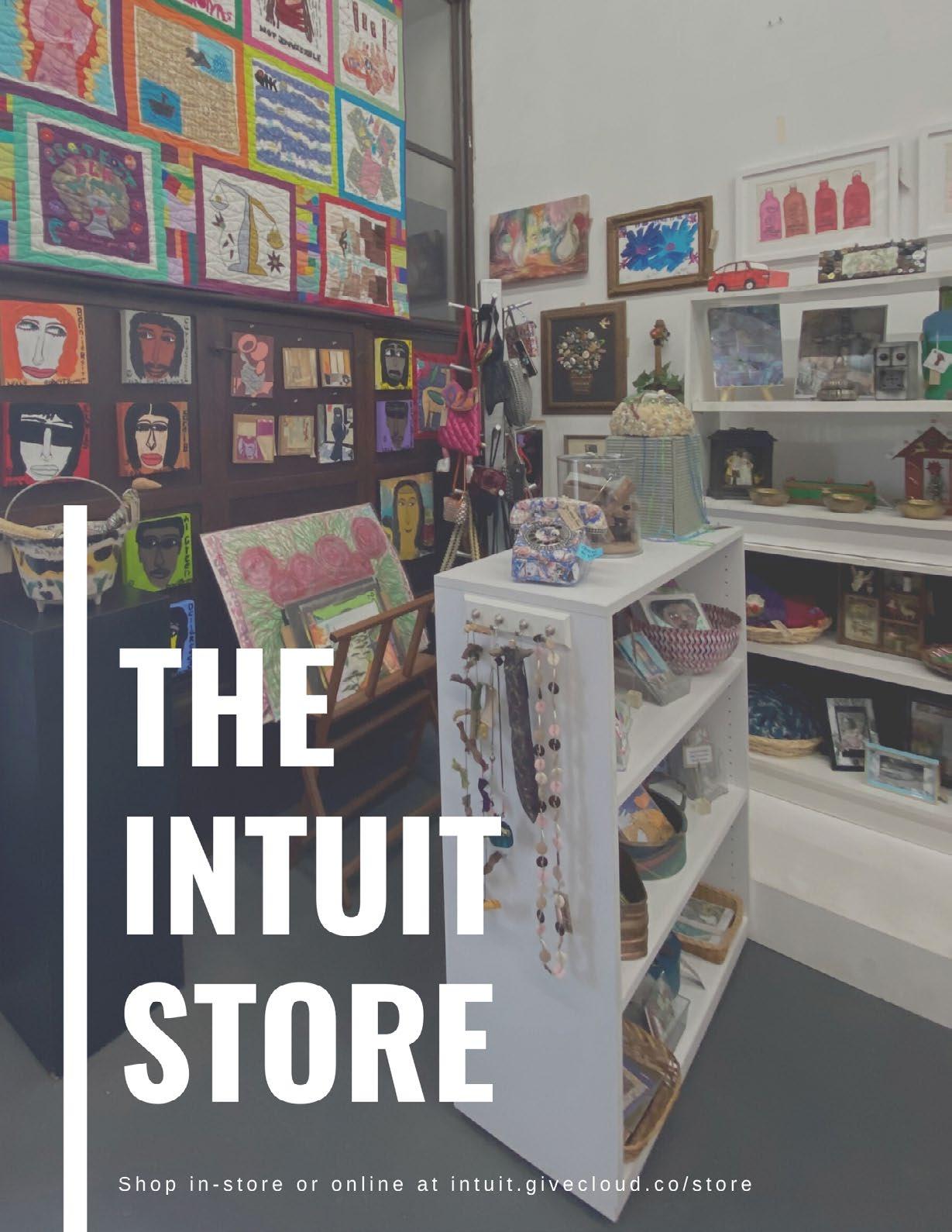
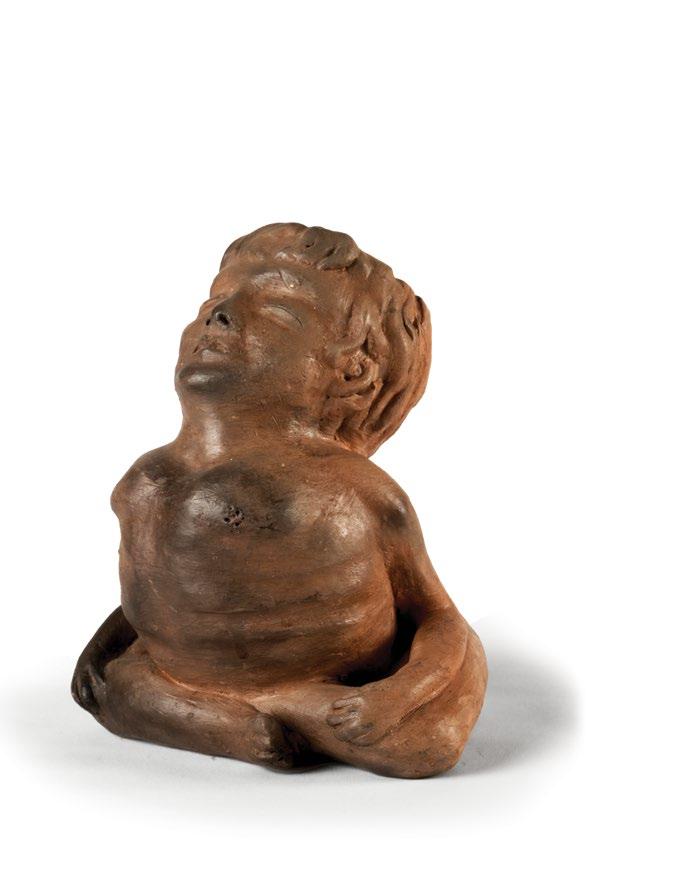
ABOUT INTUIT:
Intuit champions the diverse voices of self-taught art, welcoming both new and familiar audiences. Founded in 1991, Intuit presents the work of self-taught artists—also known as outsider art. These artists typically work outside the mainstream and may have faced societal, economic or geographic barriers to a traditional path of art making. By presenting a diversity of artistic voices, Intuit builds a bridge from art to audiences.
18
INDEX
letter from the president by debra kerr
SPAIN’S ART ENVIRONMENTS ARE FURTHERED EXPLORED IN A NEW BOOK: SINGULAR SPACES II by jo farb hernández
STORIES OF IMMIGRATION TOLD THROUGH ART
by dana boutin
MEANINGFUL ART EXPERIENCES WELCOMED ALL by isabel axon-sanchez
book reviews by william swislow support leadership RECENT ACQUISITIONS
35 membership
Cover: Pascual Zapater Barrús (b. 1938), Barcelona Province, Photo: Jo Farb Hernández, July 28, 2016
Back Cover: Esteban Martín Martín (1926-2011), Málaga Province, Photo: Jo Farb Hernández, May 1, 2016
The Outsider is published once a year by Intuit: The Center for Intuitive and Outsider Art, located at 756 N. Milwaukee Avenue, Chicago, IL 60642. Prior to Fall 1996, Volume 1, Issue 1, The Outsider was published as In'tuit. 05
Above: Georgia Blizzard (American, 1919-2002). Mediator, 1993. Clay, 8 1/2 x 7 x 6 in. Collection of Intuit: The Center for Intuitive and Outsider Art, gift of the Susann Craig Estate, 2023.1. Photo by John Faier
ISBN 978-0-9990010-3-5
06 12 24 30 33 16
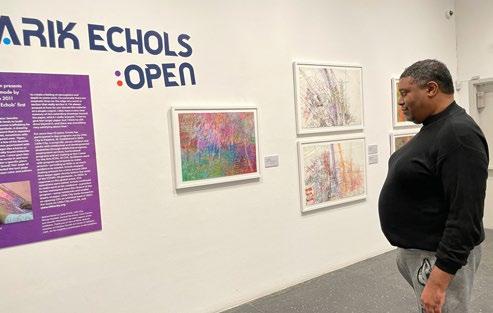


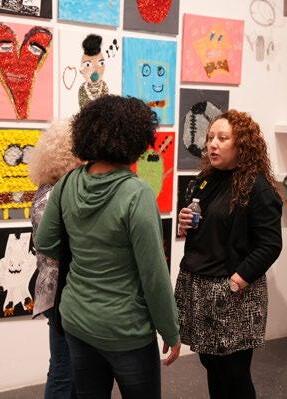
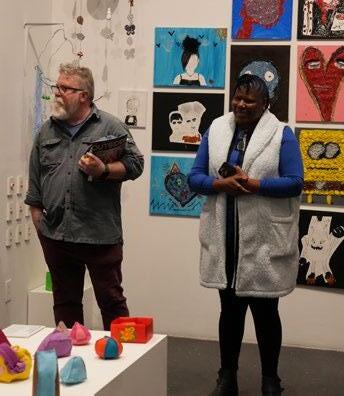
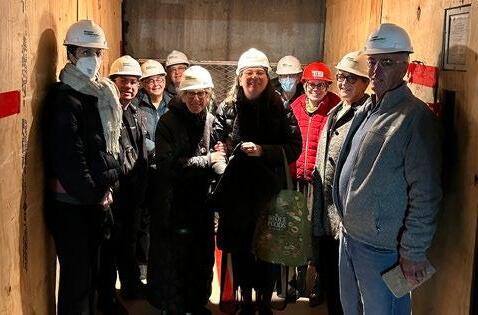
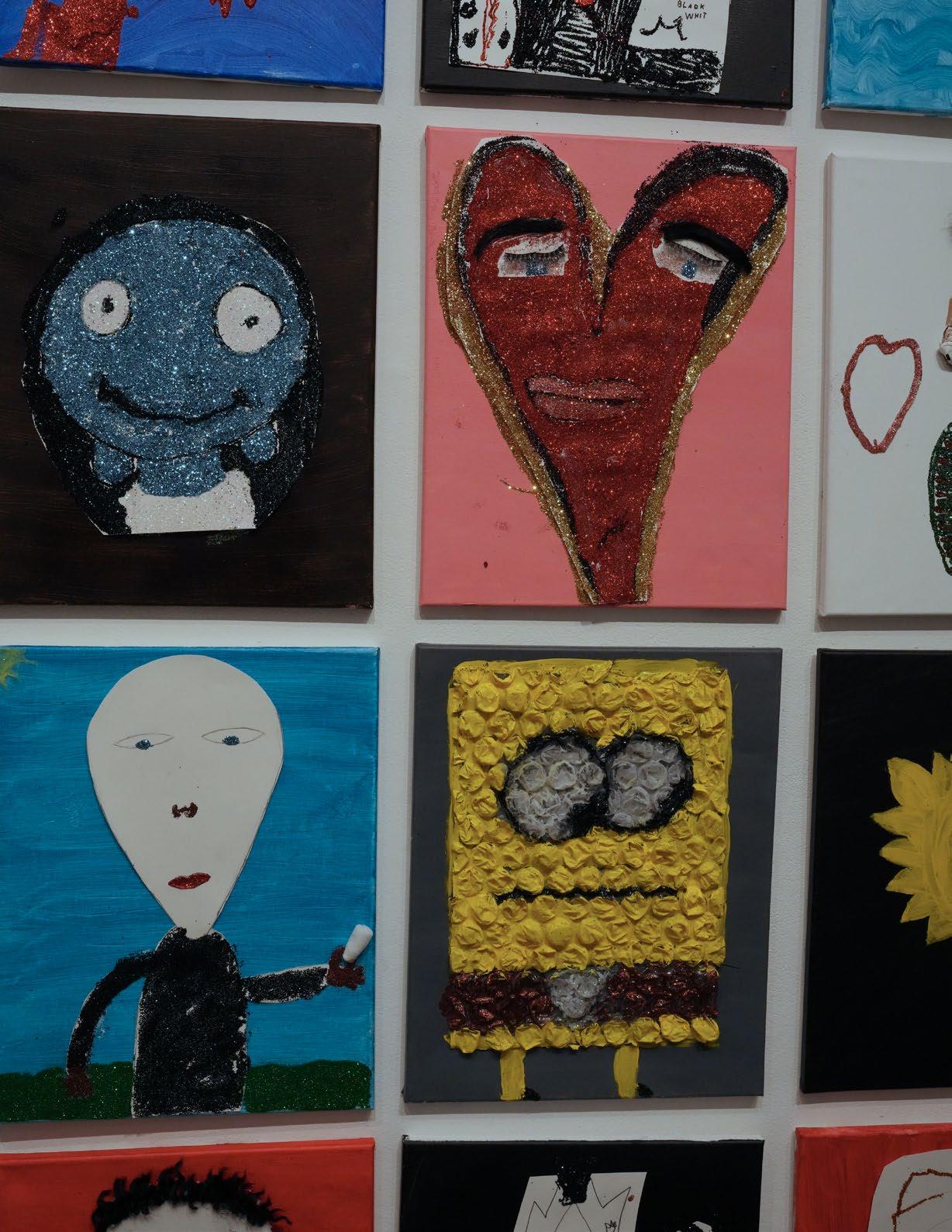

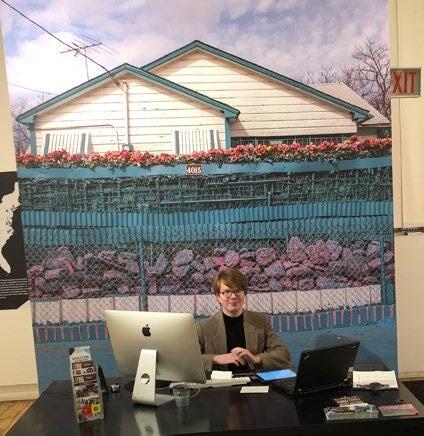 Photos by Cheri Eisenberg, Fred Scruton and Intuit
Photos by Cheri Eisenberg, Fred Scruton and Intuit

Dear friends of Intuit,
It’s an exciting time for Intuit, as the long-awaited renovation has begun. The museum has, since 1999, occupied space never adequately configured as a museum. Now, renovation is underway to make the building accessible, creating a welcoming, community magnet for experiencing art made by self-taught artists. The renovated museum will better serve teachers, students, community partners and the public by opening up its first-floor façade—making it clear this is a welcoming public space—and expanding usable audience space from one to three floors and adding two additional art galleries, a dedicated education and art-making studio named in honor of Mr. Imagination, the Center for Learning and Engagement or CLEO—a community gathering space, and an updated exhibition on the life and art of worldrenowned artist Henry Darger.
All this is happening right in our existing space. You may be unaware that Intuit occupies about two-thirds of a threestory condominium building comprised of three interconnected older buildings in Chicago’s hip and trendy West Town neighborhood. The oldest, which housed the main gallery, was built in 1874. Up to now, only the first floor was available to our guests; the renovation is adding a public elevator and accessible stairs, nearly tripling the museum’s space. Although the museum is closed right now for this transformation, the team is still offering great in-person and online programs, and you can check out virtual tours of past exhibitions on the website, www.art.org. I can’t wait to welcome you back when we re-open the expanded museum in early 2025!
Warm regards,
— Debra Kerr, President and CEO
Clockwise from upper left: artist Tarik Echols visits the Tarik Echols: Open exhibition; Intuit Teacher Fellows enjoy the opening of the 2023 Student Exhibition; supporters and board members take a hard hat tour of the building renovation; Guest Service Associate Joshua Willis welcomes guests to the Ted Degener: At Home with Artists exhibition; YoPro President Shawn Grenald donates to Intuit while Board Chair Tracy Holmes looks on at the 2023 Visionary Ball; Teacher Fellows answer questions at the 2023 Student Exhibition; artist Dr. Charles Smith (center) receives the Visionary Award from board member Cleo Wilson, including a portrait by artist David Lee Csicsko (left), with 2023 Visionary Ball chair Lionel Rabb and Vivian Society member Lisa Stone (at right); and Deb chats with Cheryl Mashack, great-grandniece of artist Nellie Mae Rowe, following the screening of the film This World is Not My Own about Rowe’s “discovery” by Judith Alexander.
LETTER FROM THE PRESIDENT
The Intuit Young Professionals (YoPro) Board is fundraising for its major 2024 initiative: the commissioning of a new work by Milwaukee artist Della Wells (shown here with Deb) for the permanent collection, to be unveiled at the opening of the renovated museum.
5
LETTER FROM THE PRESIDENT
By Jo Farb
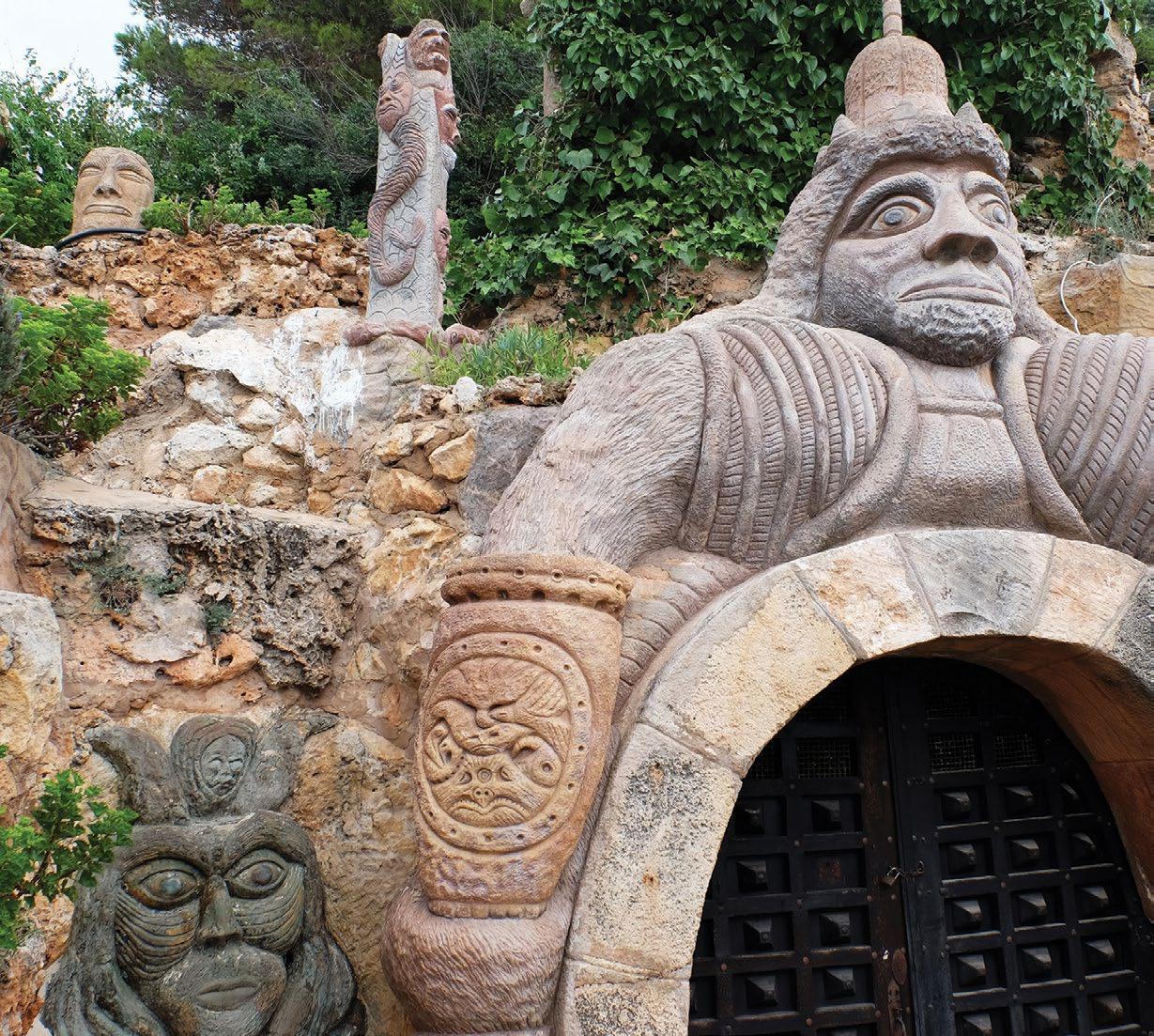
Spain's art environments are furthered explored in a new book: Singular
Spaces II
6 THE OUTSIDER
Nicolás Cabrisas Gili (1916-2013), Menorca
Photo: October 9, 2018
Hernández
All photos by Jo Farb Hernández
 Rhéa Marmentini (Hungarian, b. 1979), Valencia Province Photo: December 4, 2018
Rhéa Marmentini (Hungarian, b. 1979), Valencia Province Photo: December 4, 2018
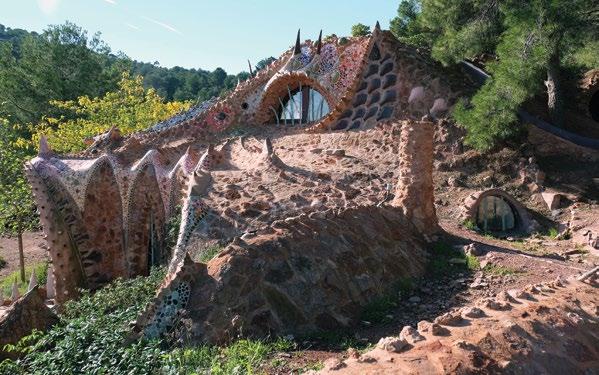
Singular Spaces II completes my comprehensive and groundbreaking study of art environments created by self-taught artists from all parts of Spain. Many of these 99 “new” sites are unknown, even within their immediate vicinity, and none have been rigorously documented, analyzed, or published before.
Over the 10 years I worked on this second volume (following 13 years on the first), I cast a wide net to ensure all regions of Spain would be represented, as would all kinds of spaces assembled with all kinds of materials. My intent, in its totality, has been to provide as encyclopedic a treatment of the field as possible.
In the introduction to that first volume of Singular Spaces (2013) I devoted much thought—and many pages—to articulating my insights into this subject, which I have developed over the course of 50 years of documenting art environments and considering a wide range of academic disciplines. This field is diverse and complex, and arriving at a comprehensive understanding and appreciation requires reflection, over time, from multiple perspectives, in the same way that the sites themselves do. And as this scholarly approach parallels the multidimensional process of physical engagement with the environments, it can fundamentally change the ways we view and interpret all kinds of artworks
and how we acknowledge and value the myriad of (sometimes conflicting) impulses behind each creative act. I, along with other early researchers, have had to break new ground in how we document and analyze these indisputably photogenic works, and, hopefully, as we have learned through our work and study, the researchers who follow us will add to the conversation with even further acumen.
I also stand by my calls for longer-term attention to these sites and the need to engage in political advocacy in order to extend their longevity. Of the 45 sites I introduced in my 2013 book, only two of which were not really fully extant at the time of my fieldwork, 10 more have essentially disappeared over the past decade, and several others are quickly deteriorating now that the artists have passed away. It has been unquestionably discouraging that these environments, an important element of Spain’s visual and cultural
7 SINGULAR SPACES II
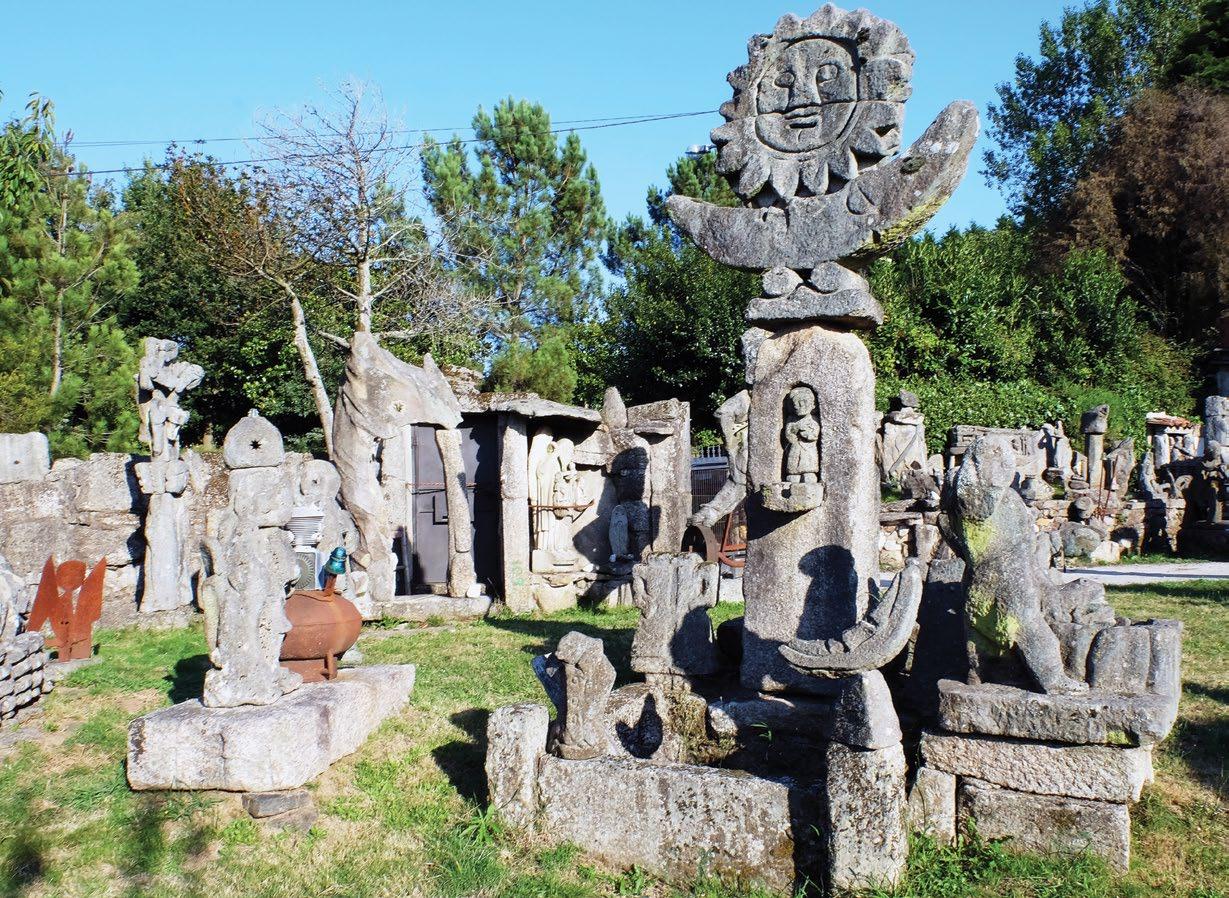
heritage, have been almost completely ignored on a national level by both the government and its most important museums. Perhaps this new book will help motivate the authorities to begin to prioritize the maintenance or restoration of at least the most extraordinary sites, supporting them so that the artistic voices of their creators can be preserved. This will not only provide representation to those who are least often heard but will impart a more balanced, expansive, and authentic understanding of the very nature of creative expression.
This indifference underscores the importance of comprehensive documentation of these environments, again and again, by different researchers with different viewpoints and during different seasons, an undertaking that is particularly critical while the artists are alive and working. At any given moment, the environments may be deemed by their builders to be complete statements and finished works—only to be altered the very next moment. Regular documentation, therefore, is the only reliable way to generate a sufficiently extensive and intensive record of their life spans. While each artist’s work is developed independently and individually, it does, indeed, take a village to celebrate their creativity.
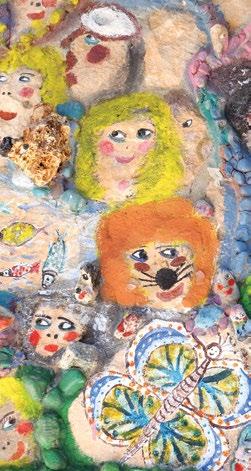
8 THE OUTSIDER
Opposite page:
Photo: August 23, 2019
Right:
Photo: June 19, 2018

This is imperative, because art environments are not an isolated phenomenon, nor are they particularly rare: Hundreds of sites have been recorded globally, and I suspect that there are easily hundreds more that have not yet been “discovered.” These artists and their works have much to teach us about the process of creation and about the confidence to undertake a path radically different from the one they had followed during the prime of their working lives. Rather than being paralyzed by the kind of misplaced hobbyist worries such as “I can’t even draw a straight line,” these creator-builders usually just enthusiastically start working, building, and improving until, years later, they realize their daily efforts have progressively developed into a monumental creation. They often amaze themselves in the process: “If someone had told me I would make something this big/elaborate/complicated, I never would have believed it,” has been the proudly surprised observation made to me by more than one maker. And because there is neither playbook nor model for what an art environment “should” look like (and typically these builders have little, if any, knowledge that other such sites exist or, even more, that such a genre has been described, defined, and studied), their continuing pleasure at the results of their labors leads them to and through complete freedom of expression. “If I had learned from someone else, I could make a mistake,” José García Martín (known as Pillimpo) earnestly told me, “but since I taught myself, I can’t make any mistakes.”
Photo: June 28, 2021
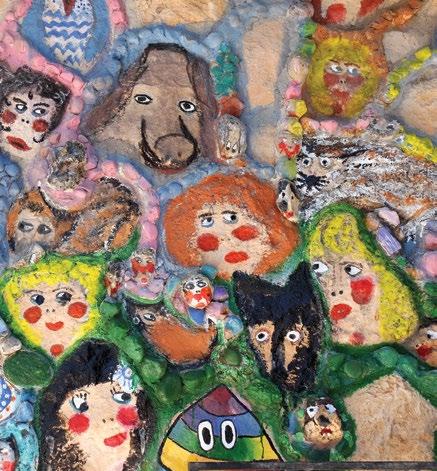
This monumentality triggers a transformation in the individual identity of the creators, and, as their private persona begins to evolve into a more socially prominent identity, they become subject to previously unforeseen and unimagined characterizations. “Artist” is often a startling (and perhaps disconcerting) identification they had not contemplated before, but other, less gracious terms are also thrown about: “crazy,” “garbage collector,” “lawbreaker.” How they navigate these changes and how the various communities impacted by their work—their neighbors and local governments as well as global aficionados of art environments—respond to their new identity may affect the rest of their days, as it likewise often affects the appearance and endurance of the sites themselves.
As I visited these artists to document their environments, they were frequently surprised at the depth of our lengthy and open-ended interactive interviews. Assisted by my status as an outsider who had traveled halfway across the world
9 SINGULAR SPACES II
Esther Mena Pérez (b. 1932), Cuenca Province
José Cao Lata (b. 1931), A Coruña Province
Tarsici Baget i Llobet (1922-2001), Tarragona Province
Opposite page:
Josep Almar Pujol (known as Ratpenat) (b. 1949), Girona Province
Photo: August 11, 2021
Below: Freddie Zuidijk (Dutch, b. 1956) Málaga Province
Photo: May 20, 2016
Aurelio Pérez López (dates unknown, ca. early to mid-20th century), Guadalajara Province
to reach them, I suspect that many were more open to me than they might have been to locals, as they began to grasp the broader public value of their private labors. Through these discussions, I coaxed out the history of the development of their work, their inspirations, processes, techniques, tools, and intents, and, as we became more comfortable with each other, over time they became my true collaborators, offering suggestions, digging out old files and photos, making sure I understood their intentions and could interpret them correctly. Our collaboration was based not only on our words but on the cooperative atmosphere, the ambiance, the impressions that made my visits wholly experiential.
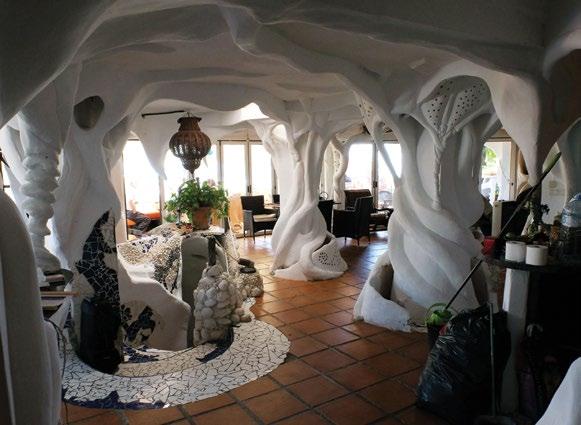
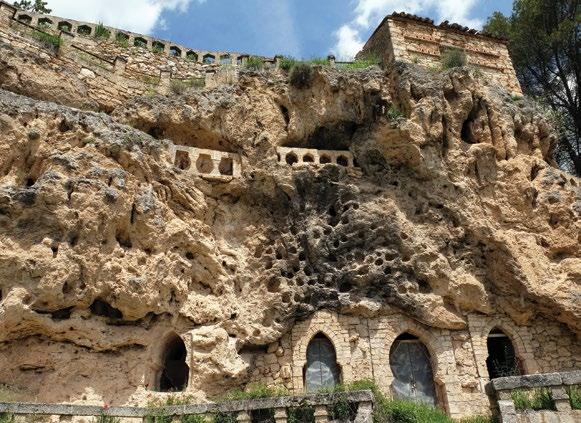
So as we worked together over the months and years, I, in turn, was surprised, and also impressed, by these creators, by their audacity and their bold self-confidence to try something they had never tried before, and by their fearlessness as they pressed ahead to build something out of the ordinary, even if it would ultimately change their standing in society and within their family.
The universality of the need to create, and the issues that are confronted when one does so in a public and non-sanctioned way, are relevant to art and artists worldwide. But, in addition, these artists have, over time, become incomparable models of tenacity and commitment to an ever-evolving goal, as they creatively pivot to address unforeseen challenges and follow their hearts while they learn by doing, add success to success, and slowly allow their creative force to change their lives.
It reminds me of the tales of young immigrants who cross oceans or other vast and unknown territories with no familiarity with the country to which they are going, no knowledge of the language that is spoken there, no specific place to land, no one to help, no money to survive—yet they dive off the edge of their home continent to find a new and better world. And in a similar way, these art environment builders have likewise left behind their old identities as they created a new and better world for themselves, albeit bridging different but perhaps equally challenging frontiers as

10 THE OUTSIDER
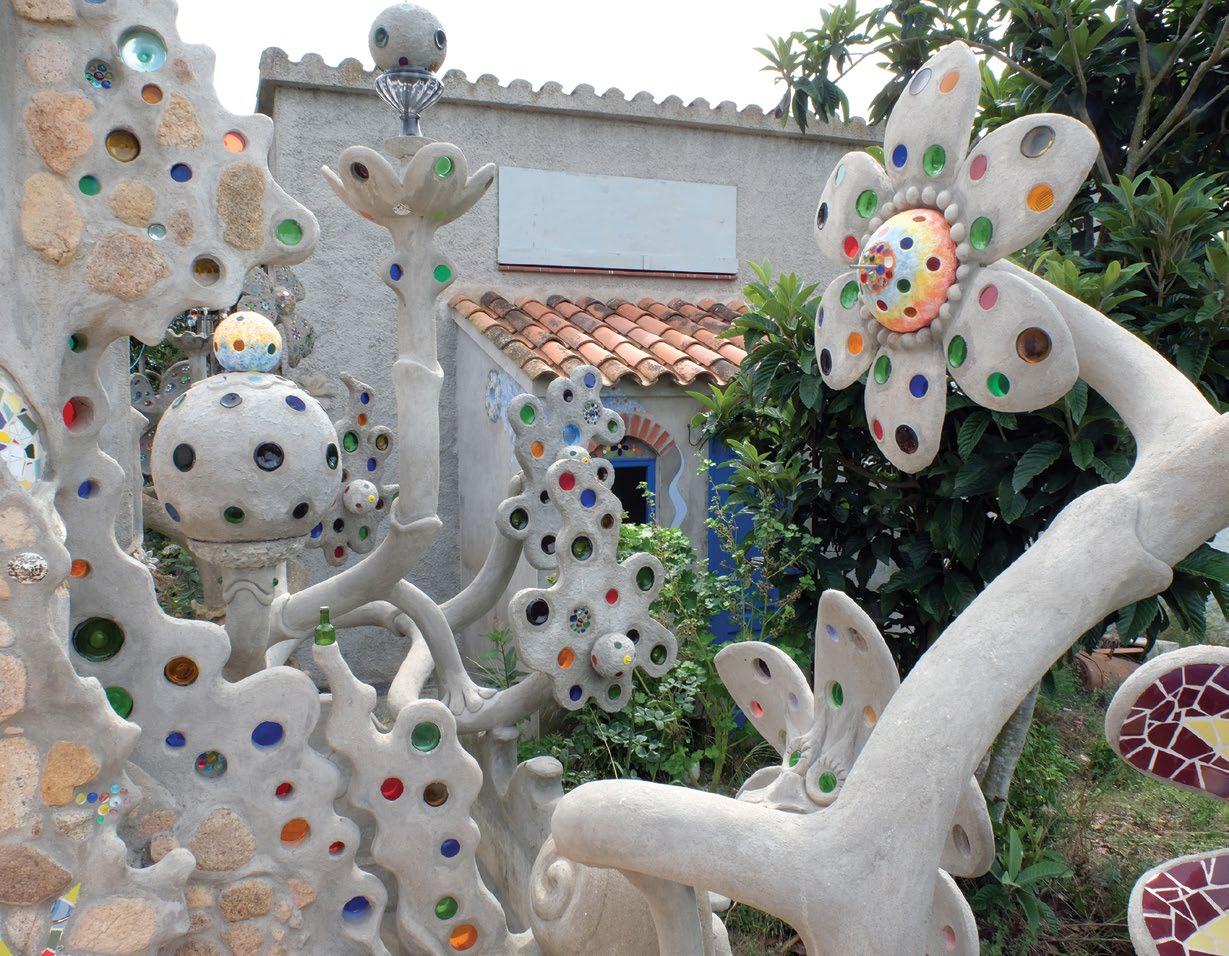
they made use of locally available materials and channeled an inner creativity that they may not have known they had or that they spent years suppressing until they could finally break free.
And the wonder of these spaces, as the artists stepped back to review their decades of work, must have echoed the incredulity of those intrepid immigrants, marveling at how far they had come and what they had achieve:
I did this!
How on earth did I do this?
And, because of what I was able to do, my world will never be the same.
Interested in seeing these amazing environments for yourself? Jo Farb Hernández, author of Singular Spaces books, will lead an Intuit travel adventure to Spain in 2025. Mark your calendars, and let Tina Horton, membership coordinator, know of your interest at tina@art.org.
1Jo Farb Hernández, Singular Spaces II: From the Eccentric to the Extraordinary in Spanish Art Environments (Milano, Italy: 5 Continents Editions, 2023). This text is excerpted from the Introduction to that volume.
2Jo Farb Hernández, Singular Spaces: From the Eccentric to the Extraordinary in Spanish Art Environments (Watford, UK: Raw Vision; San José, CA: Natalie and James Thompson Art Gallery; Aptos, CA: SPACES, 2013).
11 SINGULAR SPACES II
STORIES OF IMMIGRATION
T H R O U G H A R T
Intuit investigates new narratives, themes and experiences of self-taught immigrant artists in Chicago.
In a city continuously transformed by successive waves of immigration and migration, what are the cultural contributions of these immigrants’ arrivals? What were their unique experiences and opportunities? What is the role of cultural institutions in honoring their creativity and resilience?
Intuit’s exhibition for Art Design Chicago 2024 will explore these questions through an intimate examination of artists who came to Chicago and developed or expanded on a self-taught art practice. Building on the success of its 2018 initiative, the Terra Foundation for American Art’s citywide series of exhibitions and events will highlight Chicago’s artistic heritage and creative communities. Intuit’s own investigation has unearthed some intriguing trends.
As a Terra Foundation Research Fellow, I have been working with Intuit’s chief curator, Alison Amick, to identify artists, locate
By Dana Boutin
artworks, and reach out to partners and collaborators, and to seek out perspectives not often considered through the lens of artists’ immigration experience.
Following up on the recommendations of seven community advisors, we are forging relationships with an array of experts and family members to deepen our knowledge. For instance, for Drossos P. Skyllas, we were fortunate to connect to his great-nephew Michalis Kyrannis, thanks to Jennifer Barclay, an author based in Greece’s Dodecanese Islands. The proprietor of a family house museum in Kalymnos, Kyrannis shared many previously unknown details (including the first known painting) of Skyllas’s early life in Greece.
Thanks to the insights of historian Dan Pogorzelski, we visited the home of Jan Słodyczka-Maśniak, constructed in a traditional Zakopane building technique, using notches instead of nails, to learn more about the Polish Highlander community and enhance our understanding of the background and work of artist Bronislaw “Bruno” Sowa.
12 THE OUTSIDER
12
IMMIGRATION TOLD
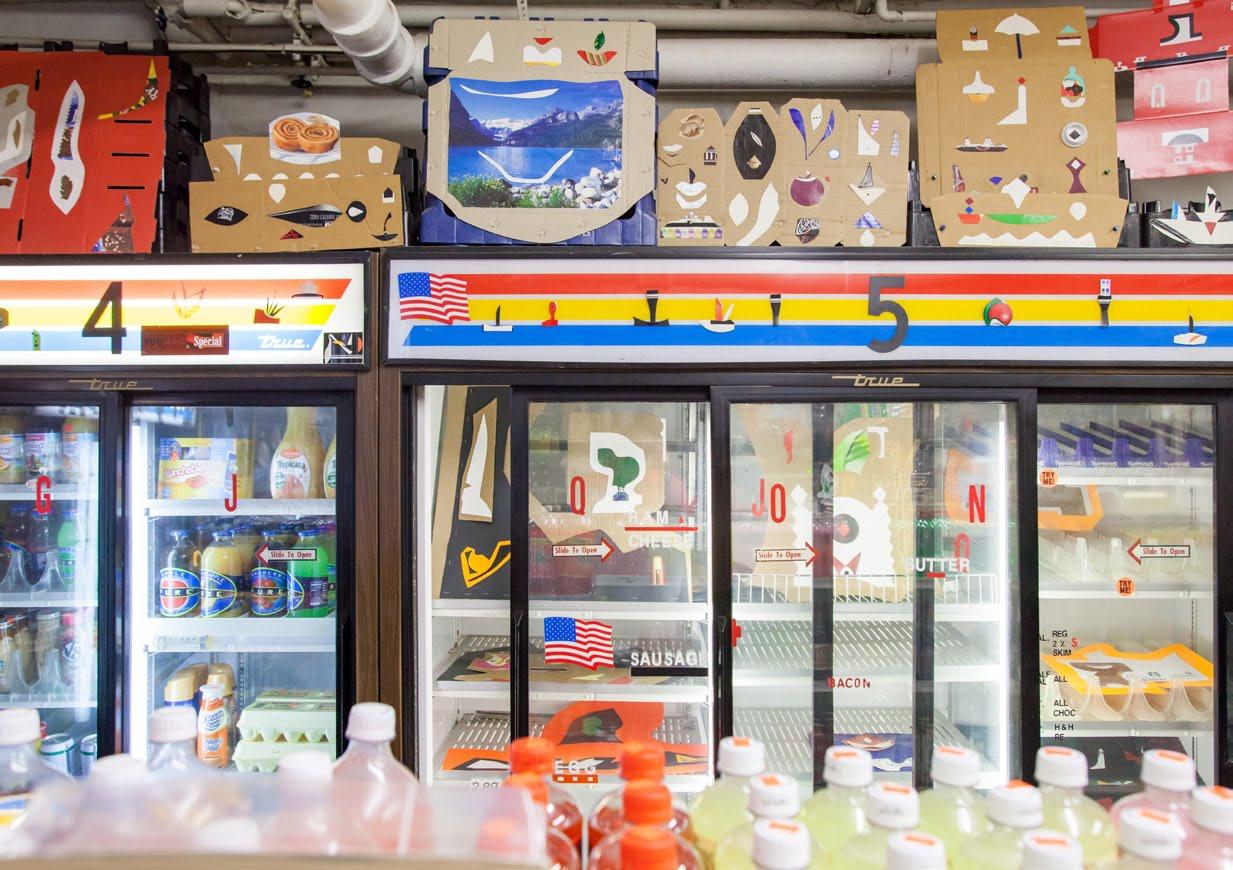
13 STORIES OF IMMIGRATION TOLD THROUGH ART
Thomas Kong artwork repository, The Back Room at Kim’s Corner Food, Chicago, July 2016.
Photo by Dan Miller

Developing themes and narratives
Several themes have emerged: longing for one’s homeland, labor and individual expression, and tendencies toward assimilation. The exhibition narrative will introduce early examples of selftaught immigrant artists; center on flourishing recognition in the second half of the 20th century; and conclude by highlighting the role that immigrant artists continue to play.
The exhibition focuses on works made between the 1940s to the present time. We anticipate including work by Carlos Barberena (Nicaragua), María Enríquez de Allen (Mexico), Tae Kwon “Thomas” Kong (North Korea), Aldobrando “Aldo” Piacenza (Italy), Pauline Simon (Russia), Genya “Jennie” Siporin (Poland), Skyllas (Greece), Sowa (Poland), Stanley Szwarc (Poland), Charles Warner (Poland/then Prussia), Derek Webster (Honduras/Belize) and Badaskhan “Betty” Zakoian (Armenia), and we continue to engage new contacts to learn about artists new to us. It is worth noting many of these countries’ boundaries shifted during the 20th century.
Labor and individual expression
In the 20th century, Chicago was an industrial hub with a demand for labor. Immigrants found employment, despite language barriers, in steel mills and manufacturing plants (until their decline in the 1980s). These positions did not require skilled craftsmanship and left little room for individual expression. Yet immigrant artists found ways to fuse labor practices with traditional crafts, as in religious-themed original artworks by Piacenza and Szwarc. The sheet metal roofs of Piacenza’s modeled cathedrals reflect his time working in a sheet metal factory. Szwarc, a metal worker at a dental equipment company, and Webster, who worked as a janitor, used materials from their jobs to include in their art practices.
Generational trends
Family and neighborhoods are often the first audiences for self-taught artists’ work, and their non-traditional places of exhibition, sometimes of their own making, include homes and places of business, settlement houses, libraries, and non-art museums. Piacenza, Enríquez de Allen and Webster used their homes as studios and sites for showing their work, which became what is now known as art environments.
14 THE OUTSIDER
Interior of Kim’s Corner Food, May 2015.
Photo by Dan Miller
Similarly, Kong transformed his convenience store into a studio, art environment and, in what he called “The Back Room,” an exhibition space for his and other contemporary artists’ work. We are exploring how the Hull-House Settlement, South Side Community Art Center and Casa Aztlan supported the activity of migrant and immigrant artists, with an imperative that art be located in the neighborhoods where they lived.
As we dig into the backgrounds of these artists, we’ve learned about other family members in the arts. Where the creativity of many of the artists blossomed later in life, after working to support their families, several of their children and grandchildren embarked on creative careers, seeking art degrees earlier in life. These trends shed light on issues of access to resources— including higher education and dedicated
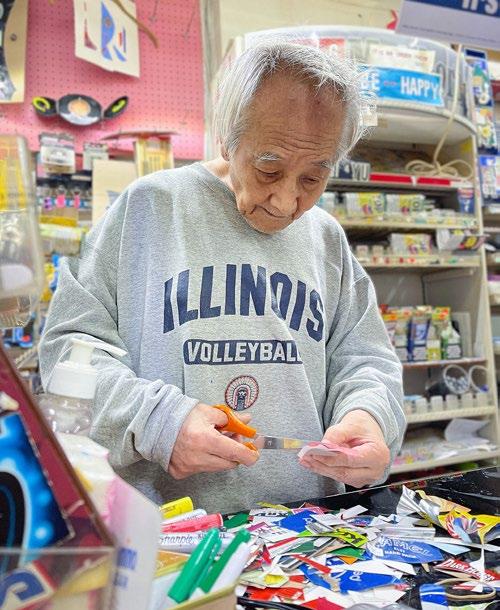
artmaking time—and the upward mobility of immigrant families. Many families act as stewards of artworks and voices of cultural memories, carrying on traditions and crafts. Balancing against this sense of progress are biases toward ethnic, craft, and folk traditions and the loss of cultural heritage over generations.
Multiplicity of individual experience
There is not one answer to the questions the exhibition presents but, rather, many stories and a continual unfolding. The range of subject matter and artistic styles reflects artists processing distinct traditions and memories, intersecting with everyday experiences of living far from homeland. Taking a critical look at artists through the lens of their immigration experience and providing culturallyspecific and art-historical contexts, this exhibition will open up new avenues for audiences to connect with and expand the visual and cross-cultural narratives present in these artists’ work.
The exhibition prioritizes personal experiences expressed through art and avoids generalizing the immigrant experience. We are learning about artists from both communities with large immigrant populations in Chicago, for example, from Mexico and Poland, and smaller groups from Armenia and North Korea. While we can’t represent every community throughout Chicago’s history, this research seeks out connections to more artists, especially artists of color and those from major sources of immigration to Chicago, for example, China and Southeast Asia. This project opens the door to further exploration of stories highlighting the creativity and resilience of immigrants in Chicago shared over time.
15
STORIES OF IMMIGRATION TOLD THROUGH ART
Thomas Kong, working at Kim’s Corner Food, January 2023. Photo by Dan Miller
Intuit expands its ability to make meaningful self-taught art experiences accessible to all
By Isabel Axon-Sanchez


1 TFP student exhibition reception. Photo by Intuit
2 Dr. Charles Smith at Visionary Ball 2023. Photo by Fred Scruton
3 IntuiTeens with Youth Coordinator Cielo Aguilera and mentor Skylar Pauel.
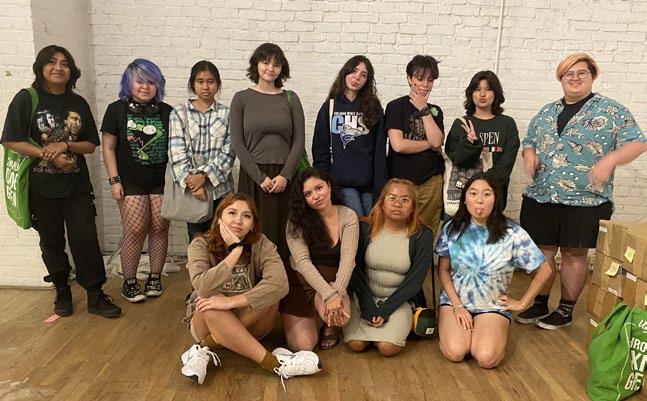
2 3 1
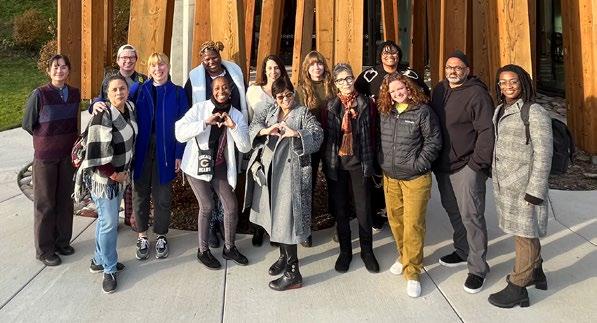
Outreach made art approachable
Thirteen summer IntuiTeens were introduced to creative professionals, art spaces and new neighborhoods, experiences that broadened their thinking about their futures. The Teacher Fellowship Program welcomed 17 cohort teachers from 11 partner schools for the 20232024 academic year. By being introduced to the powerful storytelling, materials and techniques used by Intuit’s artists, 500+ Chicago Public School students benefited from selftaught art-infused curricula developed during the 2022-2023 TFP cycle.
Programs inspired connections and ideas
In partnership with local artists and organizations, a variety of monthly Art After Work guided workshops offered dozens of participants a safe space for creating. Other significant public events included the symposium series Artists First Conversations: Inclusivity for Artists with Disabilities; a screening of the film This World is Not My Own; a National Poetry Month celebration; a three-part virtual conversation on the importance and future of Intuit’s Henry Darger Room; and Theatre Nobody’s The Flashlight Play about access to art.

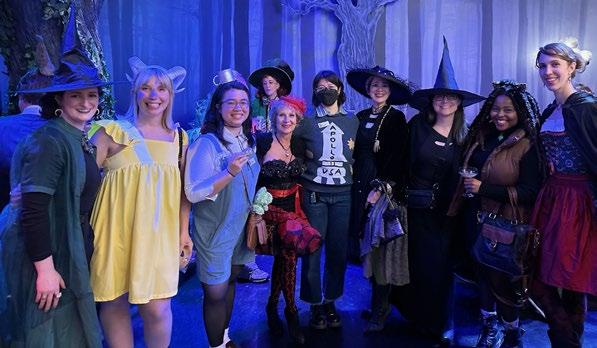
Exhibitions told artists’ authentic stories
Exhibitions provided Chicago youth and guests of all backgrounds with a window to new worlds and ideas.
Roman Villarreal: South Chicago Legacies
June 17, 2022-January 8, 2023
Tarik Echols: Open
December 9, 2022-May 14, 2023
Creative Growth Art Center: Selections from the Collection
December 9, 2022-January 29, 2023
Ted Degener: At Home with Artists
January 19-September 4, 2023
What Are Words For?
February 3-March 19, 2023
Hand-Drawn Circle: Arts of Life Studio
Past and Present
March 23-May 14, 2023
Teacher Fellowship Program Student Exhibition 2022-23
May 20-June 25, 2023
Purvis Young: Works on Paper
June 30-September 4, 2023
Recent Acquisitions
June 30-September 4, 2023
4 Teacher Fellows visited the John Michael Kohler Arts Center.
5 Intuit staff members at “Friday the 13th in Wonderland,” hosted by the YoPro board. Photo by Intuit
6 Art After Work participants with faciltator Dionne Victoria Milton. Photo by Intuit
17 WHAT’S HAPPENING AT INTUIT RECENT ACQUISITIONS
6 5 4
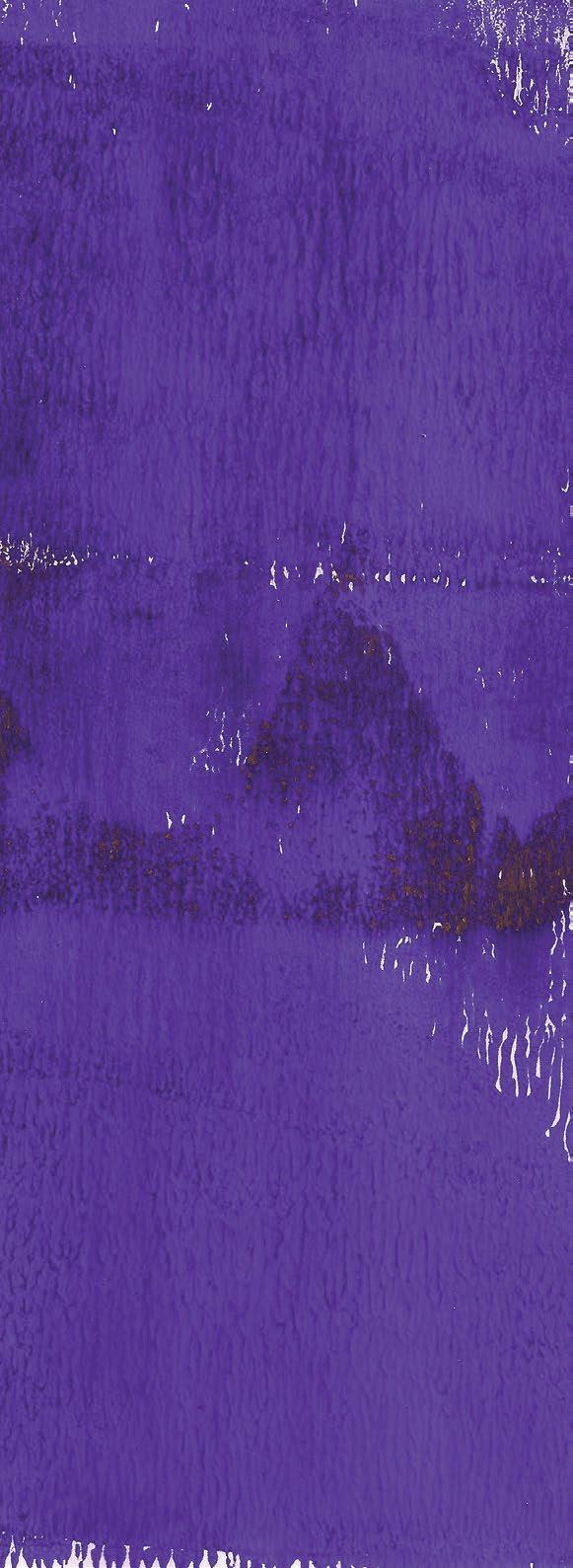
RECENT ACQ UIS ITI ONS
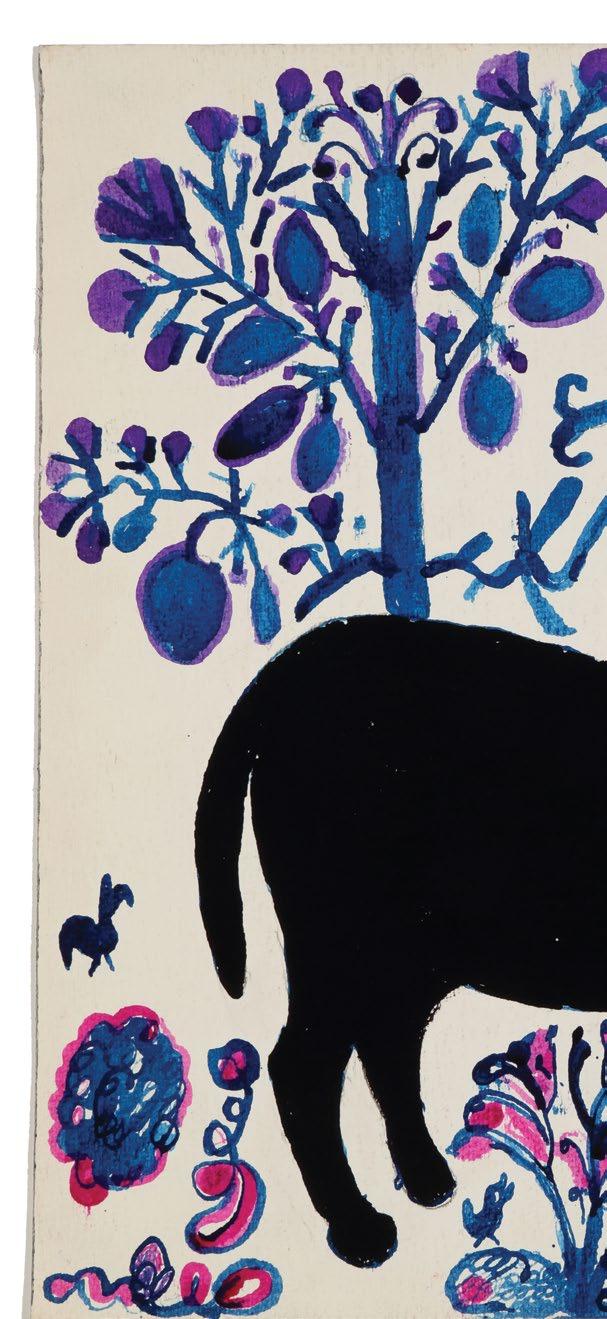

19
Nellie Mae Rowe (American, 1900-1982). Black Dog, 1982. Mixed media on paper, 15 x 20 in. Collection of Intuit: The Center for Intuitive and Outsider Art, gift of The Judith Alexander Foundation, 2023.42.
ACQUISITIONS
Photo courtesy of The Judith Alexander Foundation
RECENT
In summer 2023, Intuit screened This World is Not My Own, a new documentary about Nellie
Mae Rowe, which tells the story of the remarkable artist and her relationship with Judith Alexander. For most of her life, Rowe made art in obscurity, including vibrant drawings and handmade sculptures and dolls. Six years before her death, Alexander “discovered” and introduced Rowe’s work to the art world. The screening included a panel discussion with one of the film’s directors, Petter Ringborn, and Rowe’s great-grandnieces, Cathi Perry and Cheryl Mashack. Subsequent to the event, the Judith Alexander Foundation made a gift of a Rowe artwork to Intuit (previous page).
Daniel Aubrey generously donated a collection of 15 works on paper (next page) and a sketchbook by Florida artist Purvis Young from the Daniel Aubrey Collection. Frank Maresca of Ricco Maresca Gallery donated an additional work (this page), and Intuit exhibited these as Purvis Young: Works on Paper. Young lived most of his adult life in the Miami neighborhood of Overtown, where he recorded and portrayed the everyday lives, stories, woes and systemic traumas of the Black experience of which he was a part and a witness.
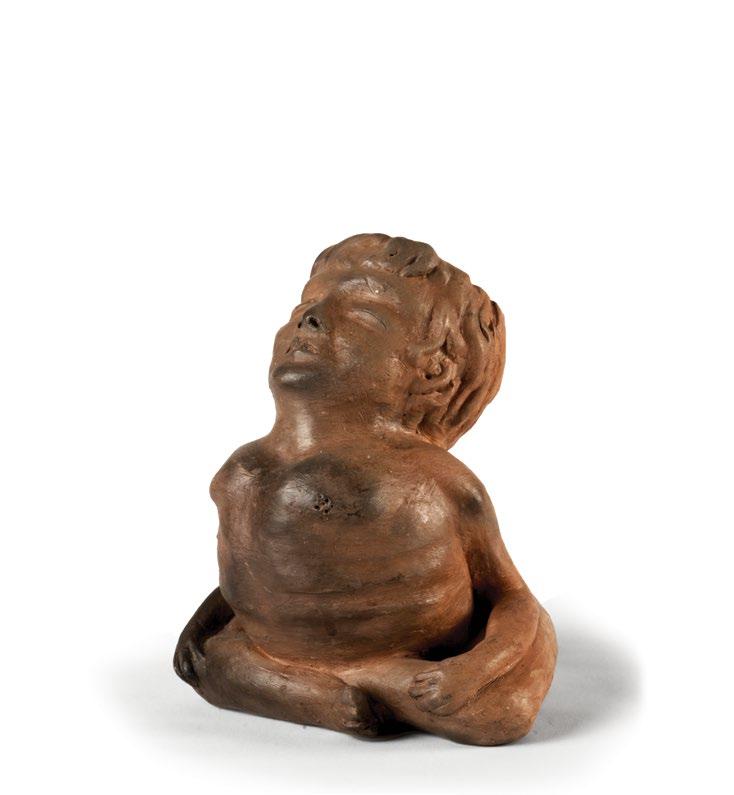
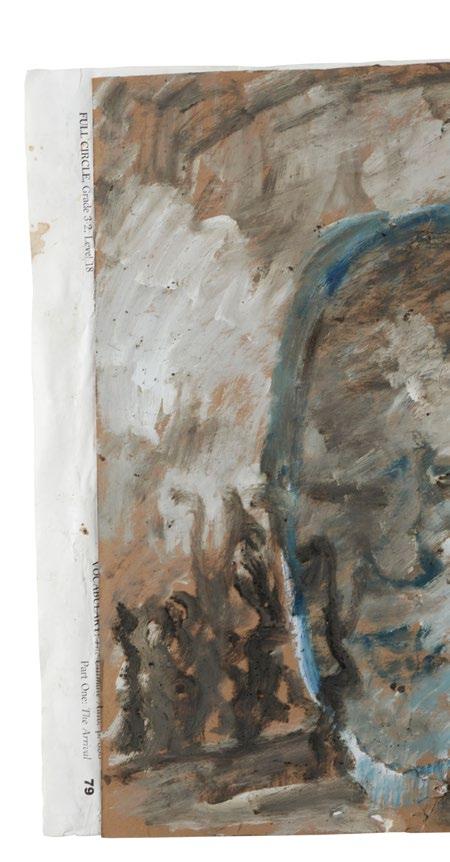 Georgia Blizzard (American, 1919-2002). Mediator, 1993. Clay, 8 1/2 x 7 x 6 in. Collection of Intuit: The Center for Intuitive and Outsider Art, gift of the Susann Craig Estate, 2023.1.
Photo by John Faier
Georgia Blizzard (American, 1919-2002). Mediator, 1993. Clay, 8 1/2 x 7 x 6 in. Collection of Intuit: The Center for Intuitive and Outsider Art, gift of the Susann Craig Estate, 2023.1.
Photo by John Faier
20 THE OUTSIDER

Purvis Young (American, 1943-2012). Untitled, c. 1985. Mixed media on paper, 26 x 48 in. Collection of Intuit: The Center for Intuitive and Outsider Art, gift of Frank Maresca, 2023.18.

William Dawson (American, 1901-1990 Untitled, n.d. Paint on carved wood. Collection of Intuit: The Center for Intuitive and Outsider Art, gift of the Susann Craig Estate, 2023.6.
21
Photo by John Faier
RECENT ACQUISITIONS
Photo by John Faier
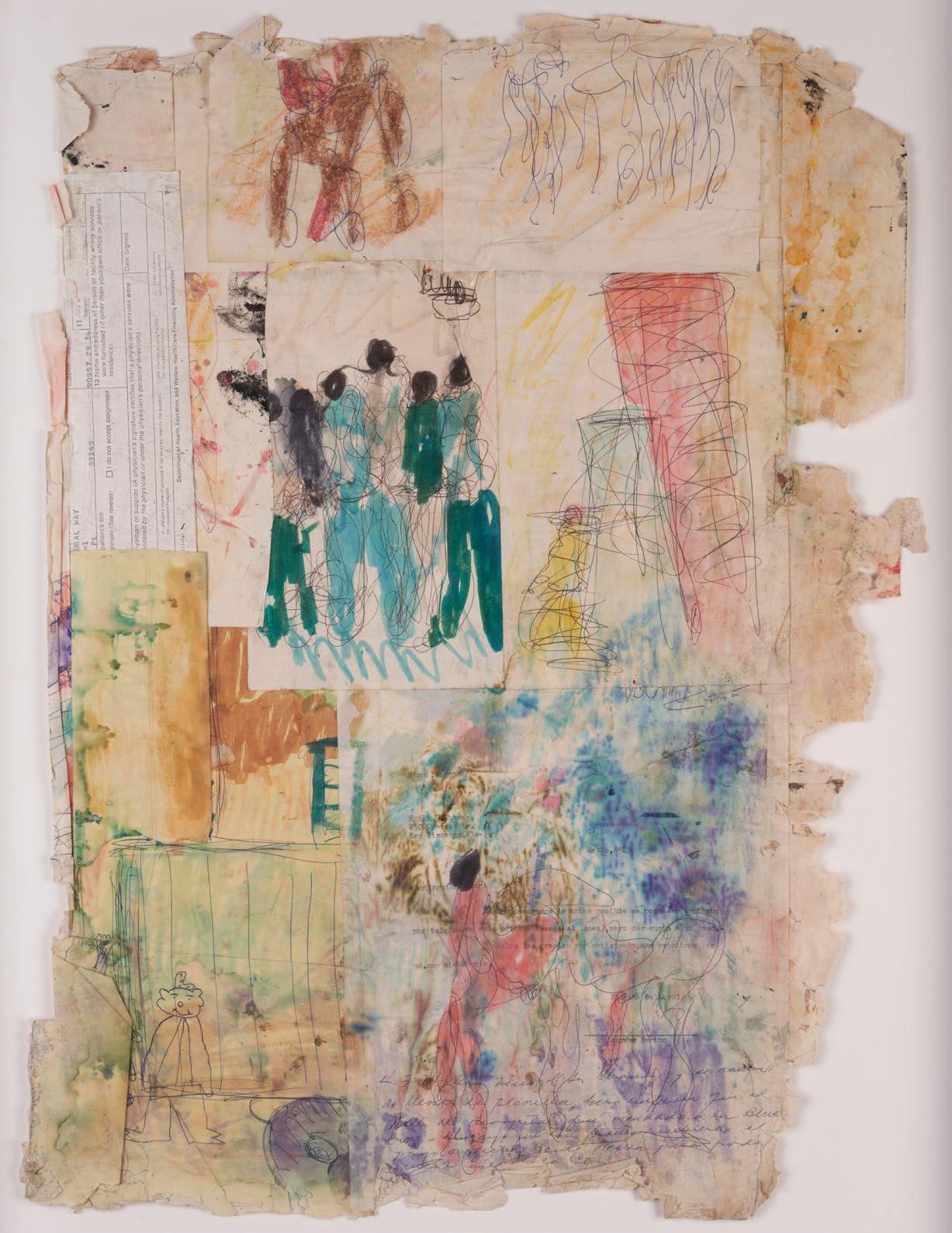
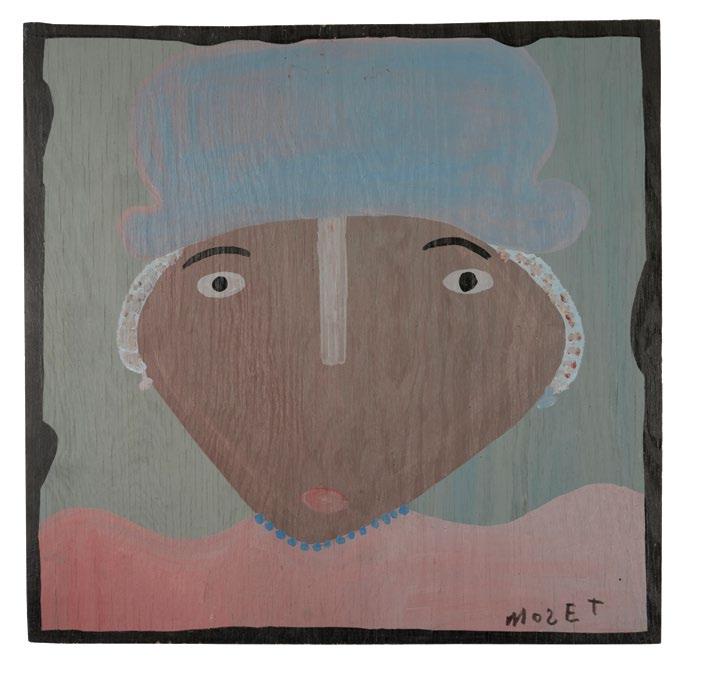
Mose Tolliver (American, 1925-2006). Martha Washington, c. 1980s. Paint on wood, 24 ¼ x 24 ¼ in. Collection of Intuit: The Center for Intuitive and Outsider Art, gift of the Susann Craig Estate, 2023.4.
Purvis Young (American, 1943-2010). Untitled, 1982. Mixed media on paper, 22 x 16 in. Collection of Intuit: The Center for Intuitive and Outsider Art, gift of the Daniel Aubry Collection, 2023.21a.
Mose Tolliver (American, 1925-2006). George Washington, c. 1980s.
Paint on wood, 24 1/8 x 23 ¾ in. Collection of Intuit: The Center for Intuitive and Outsider Art, gift of the Susann Craig Estate, 2023.3.

23
Photo by John Faier
RECENT ACQUISITIONS
Photo by John Faier
Photo by John Faier
BOOK REVIEWS
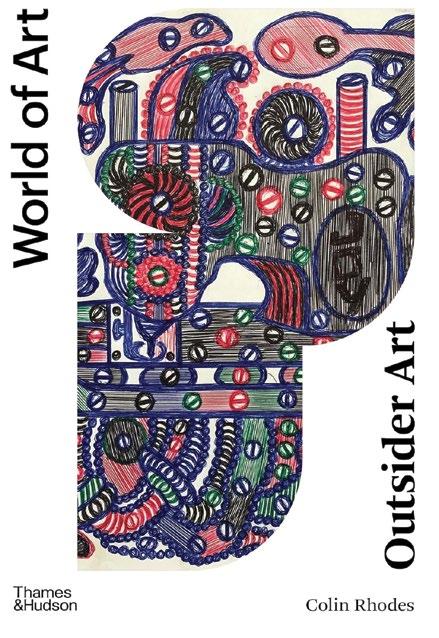
OUTSIDER ART, UPDATED AND REVISED EDITION
Photo / Outsider Art, Updated and Revised Edition, Colin Rhodes, Thames & Hudson, 288 pages, 200 illustrations, 2023. ISBN: 978-0-500-20486-3. Paperback $24.95
Colin Rhodes has written an accomplished survey of outsider art: its history, its current state and its future. His deep understanding of the field makes this book an authoritative and important document.
About that title: He is not defensive about the term “outsider art,” arguing that its well-established use makes it still a useful label. It’s also the name, not only of Roger Cardinal’s seminal 1972 volume, but of Rhodes’ own 2000 book (Outsider Art: Spontaneous Alternatives), of which this is a revised edition.
Rhodes brings a good deal more sophistication than usually in evidence on the question of labels and other touchy issues. Among the field’s warts that he frankly tackles is one of the original sins of art brut: primitivism.
“Like the surrealists,” Rhodes writes, “Dubuffet worked from the assumption that there existed a ‘primitive’ mentality that is innately different from the ‘civilized’ one, and that its operations were essentially mythic in character.… This allowed them to draw parallels between the seemingly irrational rituals that are central to daily operations in various indigenous cultures around the world, children’s play, and many psychiatric patients.”
Of course, those parallels, as well as the primitive/civilized distinction itself, have collapsed in contemporary thinking about these issues, including Rhodes’. Art brut artists, like some indigenous artists, may envision a world that is opaque to some or all of us, but that need not imply a magical
24 THE OUTSIDER
difference in their mentality. Yes, there are sometimes developmental or medical conditions that set an artist apart, but that is hardly universal.
In any case, Rhodes’ book supplies a thoughtful account of the development of the outsider art field, in part via Dubuffet’s art brut but also in the parallel (and earlier) rise of interest in self-taught art in the United States. Among the interesting points he raises is Dubuffet’s desire to keep art brut an essentially private affair. Dubuffet wanted to maintain a separation from the conventional art world lest the powers that be co-opt art brut into a canon he viewed as oppressive.
That, of course, is exactly what is happening now among major museums— mostly without objection from outsider art’s leading lights, despite occasional criticisms of exactly how the co-optation is proceeding.
Rhodes addresses other recurring issues that complicate the idea of outsider art, for example, the work of artists whose vision seems to put them firmly in the outsider art universe but whose technical training and accomplishment would seem to violate the rules of engagement—artists like architectural draftsman Achilles Rizzoli and professional photographer Morton Bartlett.
More generally, Rhodes is adept at articulating some of the core principles (and issues) that animate the concepts around art brut. “This…awareness of a constructed pictorial world in which the creator participates fully, but which is only
Rhodes’ book supplies a thoughtful account of the development of the outsider art field
tantalisingly accessible to other viewers occurs in the work of two neurodivergent artists, Roy Wenzel and Dan Miller.”
That world building is, for Rhodes, the crux of outsider art, whether its source is in mental illness, obsession, developmental disability or just intense vision. He carefully covers each of those possibilities as well as exploring other fields of art, such as self-taught photography, that may seem allied to outsider art but where the work would require that additional dimension of world building to really qualify.
And the future of outsider art?
“Historically there have been only staccato displays of outsider art in significant public museums around the world,” he writes, “resulting in the constant re-enactment of a kind of eternal discovery narrative by art world insiders every time such exhibitions occur.”
25
BOOK REVIEWS | OUTSIDER ART UPDATED AND REVISED EDITION
BOOK REVIEWS
Certain canonical masters like Henry Darger and James Castle might get permanently embedded in the larger art world narrative, but, he writes, “outsider art as a descriptor enables engagement in focused discourse on artistic practice conducted in the margins of the dominant art world and by persons who are additionally socially disadvantaged and/ or psychologically different to putative cultural norms. Outsider art need not fear its dissolution in the mainstream. If the art world appropriates its canonical figures, it is only to enmesh them additionally in its own discourses. They are not literally taken away.”
That’s a mouthful but insightful, nonetheless. And lest it sound like the book is all about debates and issues, most of it is devoted to discussions of the field’s leading practitioners, each represented by an illustrated example of their work, which leads to the volume’s main weakness—its small format greatly limits the quantity and size of those illustrations.
Ultimately, though, this is a readable introduction for anyone new to outsider art and a nuanced, non-controversial accounting of the field and its main issues for those already engaged.

26 THE OUTSIDER
SINGULAR SPACES II: FROM THE ECCENTRIC TO THE EXTRAORDINARY IN SPANISH ART ENVIRONMENTS
I began my review of Jo Farb Hernández’s first study of Spanish art environments, 2013’s Singular Spaces, with the observation that it was “so epic that even a large-format volume of nearly 600 pages can’t get the job done, so a bonus CD adds thousands more thumbnail pictures and hundreds more pages of text.”
Turns out it wasn’t enough. In the 10 years since that publication, she found another 99 places to visit, photograph and research. This two-volume set is the natural outcome of that work. As I wrote the first time around, “If creating a world-class art environment requires obsessive devotion, Hernández is a match for the creators she studies.”
Before more on the book, a quick disclaimer. Hernández’s acknowledgments reference both Intuit and me. Our support reflected confidence, based on experience with the first volume and with SPACES Archives (which Hernández directed for 13 years), that this project was important and would turn out well. Our enthusiasm was not misplaced.
These are not drive-by appreciations of cool sites. Hernández dives deep, and it had to be arduous—not only the visits to each location but also the time spent organizing and editing such a content-packed book.
The depth of her scholarship is apparent from the first entry in this encyclopedia of extraordinary Spanish creativity. Besides the expected accounts of the art and artists, she explores the history and geography of each location, providing rich context
and detail. That’s especially apropos since these artworks and their makers are so thoroughly anchored to place.
It’s a fascinating window into the history of Spain through some of its most eccentric creators, but of course it’s the exploration of the artists and their creations that give the book its true depth.
The profiles are full of artistic wonders, from Pere Bagur Massanet’s giant cisterns in the shape of a hippopotamus and other animals to the wildly imaginative tomb that inventor Gallego Herrera built for himself, giving even the Facteur Cheval’s gravesite near the Palais Idéal in France a run for its money.
“If creating a world-class art environment requires obsessive devotion, Hernández is a match for the creators she studies.”
Singular Spaces II: From the Eccentric to the Extraordinary in Spanish Art Environments, Jo Farb Hernández, 5 Continents Editions, 2 volumes of 532 pages each, 1,050 color illustrations, 2023. ISBN: 979-12-5460-018-4. Hardcover, $350
27
BOOK REVIEWS | SINGULAR SPACES II
Photo by © Hervé Couton
“Altogether this represents a trove of information and a model of thoroughness for future researchers.”
The ambition on display can be breathtaking, sometimes spilling over from an already impressive environment, as in the case of Cecilio Medrano Mendizábal, who also decorated parts of his town.
Hernández throughout manages to be scholarly without being pedantic, thorough but not wordy. It is all extremely well written and edited, with expertise dripping from every page. This makes sense given her decades of experience thinking about and documenting these places, along with the rigor of her practice as a folklorist.
Part of that rigor includes transparency about standards and practices. Her discussion of logistics, for example, includes the interesting observation that her accented Spanish may have made the artists more comfortable talking to her than to a native speaker.
She thoughtfully discusses and illustrates sites excluded from full treatment in these volumes; they look to be as interesting as the ones that passed muster. With a less careful scholar one might be tempted to quibble with those exclusions, but it’s hard to question her judgment about which sites made the cut.
Altogether this represents a trove of information and a model of thoroughness for future researchers (besides the pleasures and insights it supplies current readers). One interesting subject for such research would be the effect of her attention on the practice of these artists. Did it influence productivity or content? And to what extent has it contributed to the survival of their environments, whose long-term status is always iffy at best? Recognizing them via work like Hernández’s is the key first step, but ultimately it requires active intervention, both material and political, to give them a chance of outlasting their creators. Hernández, through her work with SPACES Archives and on the first volume of Singular Spaces, has been a vocal advocate for preservation, well acquainted with the occasional satisfaction of victory and the more frequent heartbreak of loss.
I couldn’t put it better than she does in her introduction: “It has been unquestionably discouraging that the environments introduced in my books, an important element of Spain’s visual and cultural heritage, have been almost completely ignored on a national level by both the government and its most important museums. Perhaps this new book will help motivate these powers to begin to prioritize the maintenance or restoration of at least the most extraordinary sites, supporting them so that the artistic voices of their creators can be preserved. This will not only provide representation to those who are least often heard but will also impart a more balanced, expansive, and authentic understanding of the very nature of creative expression.”
28 THE OUTSIDER
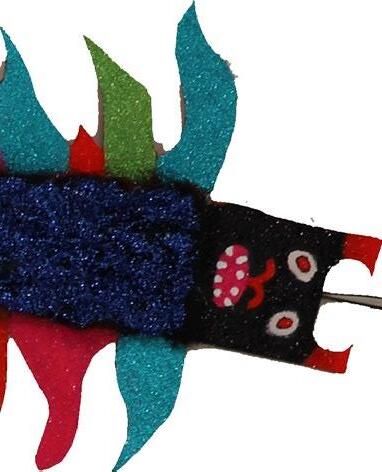
Only two reservations about this publication. The first is that there seems so much more to see than illustrated even in these massive volumes. The detailed descriptions of the artworks notwithstanding, you really wish for more photos of each environment, perhaps in a supplementary web site.
The other challenge is price. If her first volume, published in 2013, was a bargain at $80 list, this set, at $350, requires an investment. But if you have a budget at all for art books, you should consider a purchase. The lavish packaging helps justify the price, but ultimately, it’s the amazing content—photographic and text—that makes this two-volume set truly worthwhile. It is the kind of book that you will want to read over a period of months, or even years—each entry a little saga, and enough to easily amortize the considerable purchase price.
William Swislow
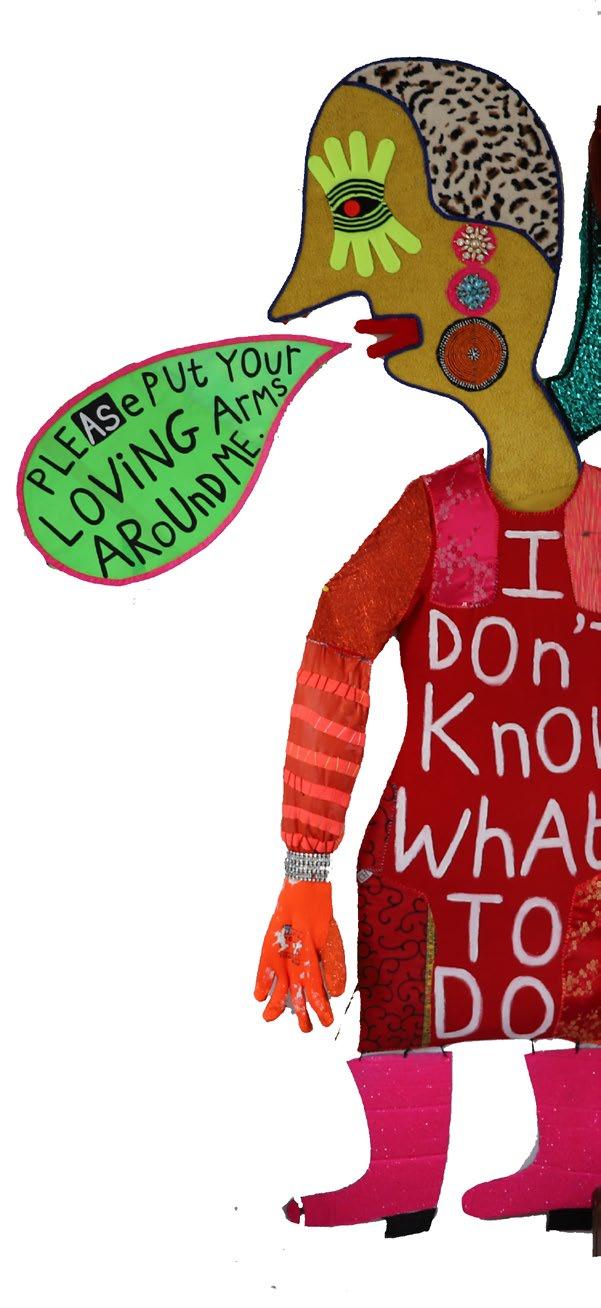
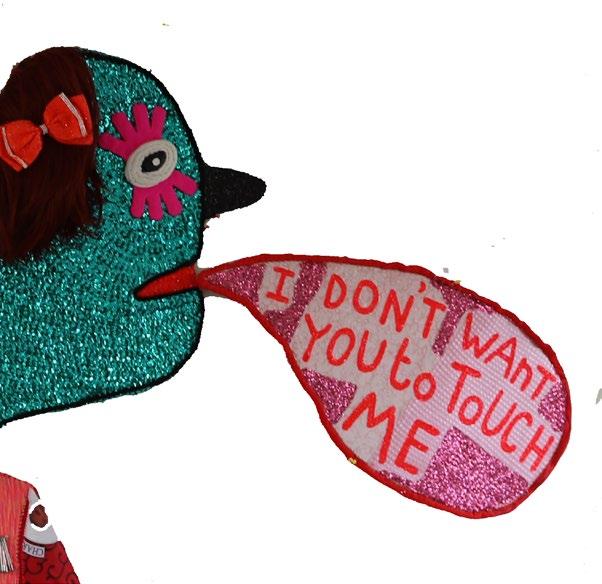
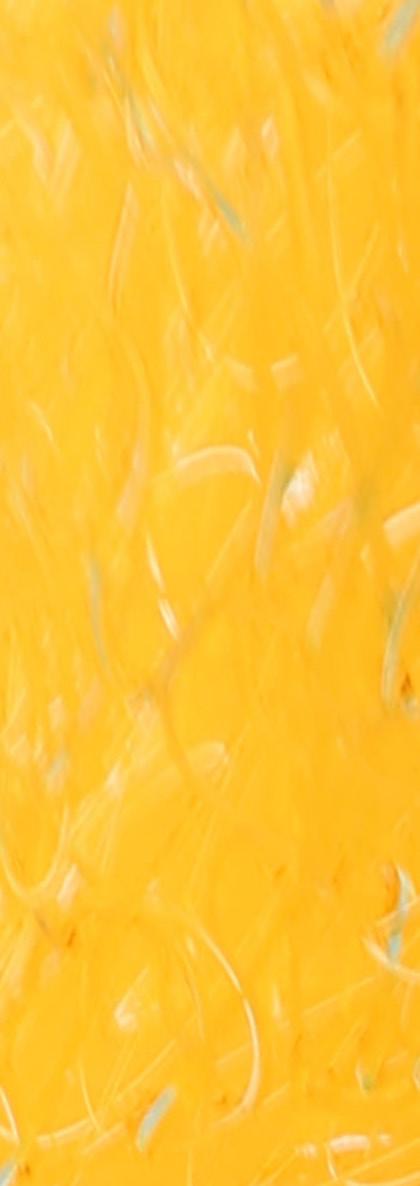
20, 2024 - January 12, 2025 1020 South St. Philadelphia, PA, 19147 phillymagicgardens.org an exhibition at
September
Your donations inspire youth, empower teachers and connect audiences. Thank you.
SEPTEMBER 2022–AUGUST 2023
$50,000+
Alphawood Foundation Builders Initiative
$25,000–$49,999
City of Chicago Department of Cultural Affairs and Special Events
Ashley and Michael Joyce
Kiyoko Lerner
Jan Petry ◊
Robert A. Roth •
Scott Lang ◊ and JoAnn Seagren
Cecelia Taman
$10,000–$24,999
Anonymous
Dorothea and Leo Rabkin Foundation
Janet r and Craig Duchossois
Sage Foundation
Gibson Family Foundation Illinois Arts Council Agency
Eugenie Johnson •
Deb Kerr ◌ and Steven D. Thompson
Ruth Foundation for the Arts
$5,000–$9,999
Daniel and Marty Boone
Nancy Gerrie
Robert Greenberg and Corvova Lee
Jean and Lewis Greenblatt ◊
Robert Grossett ◊ and Christopher LaMorte
Tracy Holmes ◊
John Jerit r
Kelly Jones
Just Folk
James Kaufmann
Ashley r and Curt Langley
Rob Lentz ◊ and MK Victorson
Michael McCluggage and Stella Lee
Bonnie ◊ and Molly McGrath
Angie Mills
César Montenegro ◊
Anthony Petullo and Beverly Trier
Tynnetta Qaiyim ◊
Phyllis Rabineau ◊ and John Alderson
Jeanne Ruddy Keen and Victor F. Keen r
Susan Manning Silverstein and Rob Silverstein
Judy and Jerry Stefl ◊
Nikki and Fredric Stein
William Swislow ◊ and Janet Franz
David Syrek ◊ and David Lee Csicsko
Dale Taylor and Angela Lustig
Terra Foundation for American Art
University of Kentucky Art Museum
Stacy Wells ◊ and Rick Farrell
Janet Williams and Ralph Concepcion •
Cleo Wilson ◊
30 THE OUTSIDER
SUPPORT
$1,000–$4,999
Paula and Gordon Addington
Meg and Steve Barnhart
Elaine and Michael Bennett
Judith and Patrick Blackburn ◊
Edward V. Blanchard and Leslie Tcheyan
Gabriella Bomben p
Dana Boutin ◊ and Sean Fogle
Carl Hammer •
The Chicago Tour Company
Diane Ciral
Moira Collins Griffin and Andrew Griffin, MD
Marjorie Freed •
Nancy Gomez
Jennifer and Scott Gordon
Charles and Kathleen Harper
Fay Hartog Levin and Dan Levin
William Hinchliff
Paige and Todd Johnson
Kathi and Tom Lind
Sue and John Lowenberg
Kevin Lyle
Bruce MacGilpin
Gary Metzner and Scott Johnson
The Niner Foundation
Deborah Oestreicher and Victor Magar
David Owsley
Diane Picciuto
Tyler Roberts p and Louisa Potthast
Douglas Robson r
Frank Maresca r
Leslie Shad and Joseph Brennan
Eugenie Shields
Jennifer Siegenthaler and Philip Cable
Emily Slabe p
Lucy Slivinski and Kahil El’Zabar ◊
Susan Stephenson
Micki Beth Stiller
Lisa Stone • and Don Howlett
Michael Sullivan
Gerald Swislow
Minna and Charles Taylor
Barbara and Victor C. Weisskopf
Marsha Woodhouse
Michelle Woods ◊
Karen Zupko
In-Kind
Paula and Gordon Addington
Daniel Aubry
Judith and Patrick Blackburn ◊
Russell Bowman
Carl Hammer Gallery
Amy Coleman Haoshu Deng p
Nancy Gorman
Eric Hill
Ruth Horwich
Nancy Josephson
Eugenie Johnson •
Victor F. Keen r
Beatriz Ledesma
Kiyoko Lerner
Pamela Lui
Jim Mackey
Thomas McCormick Gallery
Frank Maresca r
Amy Meadows
Claude-Aline and Sandro Miller
Angie Mills
Harris Nathan
Jan Petry ◊
Portrait Society Gallery of Contemporary Art
Linda Reeve
Leisa Rundquist
Ody Saban
Saul Family Collection
Luke Shemroske and Project Onward
Lisa Stone • and Don Howlett
Angela Strater
Sue and Christopher Swales
William Swislow ◊ and Janet Franz
Dale Taylor and Angela Lustig
James Zanzi
Jerri Zbiral and Alan Teller
Legacy Society
Harriet Finkelstein •
Jan Petry ◊
Phyllis Rabineau ◊ and John Alderson
Susan and Christopher Swales
Cleo Wilson ◊
Karen Zupko
31
SUPPORT SUPPORT
DONATIONS IN HONOR
Dana Boutin ◊
Marsha and Edward Fogle
Sean Fogle
Susan Stephenson
Claire Fassnacht ◌
Charles Katzenmeyer
Gillian Hodge and Dolly Palmer
Sharon Miller
Debra Kerr ◌
Jeff Boehm
Fay Hartog Levin and Dan Levin
Melissa Hilton
Warren Munzel
Kristine Westerberg
Jan Petry ◊
Mary Allen
Barbara Provus and Frederick Wackerle
Donna Speigel
Michelle Woods ◊
Scott Lang ◊ and JoAnn Seagren
Josie-Dee Seagren
Marc-Anthony Macon
Jennifer Heaton
Sherry Newton
Phil Strang
Sarah Weeks
Lisa Stone •
Lewis Koch
William Swislow ◊
Lee Swislow
Cleo Wilson ◊ and Bob Roth •
James Adams
Susan Crawley and John Murrill
Mary and Scott Donaldson
Eileen Lally
Angie Mills
Aurie Pennick
Earl Silbar
Jim Ward
DONATIONS IN MEMORY
Richard Bowen •
Lorraine and Randy Barba
Debra Kerr ◌ and Steve Thompson
Monica Geocaris
Jennifer Gilbert
Mary and Matthew Lambrecht
Robert A. Roth •
Arthur Urban
Hugh Wilson and Fran Wilkinson
Susann Craig •
Amy and Neil Coleman
Patty Carroll and Tony Jones
Karen Frerichs
Ingrid Fassbender
Bruce MacGilpin
Richard Kember
Susan and Christopher Swales
Rock Rogers
Leslee Samuelson
Eric Weisenburger
Lisa Stone • and Don Howlett
James Zanzi
Carol “Corky” Wolf
Deborah and Estia Eichten
Intuit strives to provide the most accurate information. Please notify Claire Fassnacht, development manager, at claire@art.org with any needed corrections.
Board of Directors ◊
Vivian Society •
Strategic Advisory Council r
Staff ◌
32 THE OUTSIDER
SUPPORT
Young Professionals Board p KEY HAVE YOU ALREADY INCLUDED INTUIT IN YOUR WILL, TRUST OR IRA? Planned gifts of assets, cash, art, stock and more help to inspire future audiences through outsider and self-taught art programs. Please let us know about your plans so you may receive Legacy Society benefits. Learn more by contacting Claire Fassnacht, development director, at (312) 624-8000 or claire@art.org.
BOARD OF DIRECTORS
Tracy Holmes, President
Scott Lang, Vice President
Phyllis Rabineau, Secretary
Patrick Blackburn, Treasurer and Chair of Finance Committee
Dana Boutin, Chair of Exhibitions Committee
Tim Bruce, Chair of Collections and Acquisitions Committee
Elizabeth Nelson, Chair of Marketing and Communications Committee
Michelle Woods, Chair of Development Committee
VIVIAN SOCIETY (LIFE TRUSTEES)
Richard Bowen •
Kevin Cole
Ralph Concepcion
Susann Craig •
Harriet Finkelstein
Marjorie Freed
Carl Hammer
Eugenie Johnson
Ann Nathan
Robert A. Roth
Judy Saslow
Lisa Stone
Jerry Stefl, Chair of Education Committee
Jan Petry, Past President
Benedicta Badia
Robert Burnier
Cheri Eisenberg
Kahil El’Zabar
Lewis Greenblatt
Rob Grossett
Rob Lentz
Bonnie McGrath
César Montenegro
Maya Sonal Patel
Tynnetta Qaiyim
STRATEGIC ADVISORY COUNCIL
Scott Lang, Chair
Susan Baerwald
Michelle Boone
John Jerit
Victor Keen
Ashley Smither Langley
John Maizels
Frank Maresca
Douglas Robson
Leslie Umberger
Jeffrey Wolf
• Deceased
YOUNG PROFESSIONALS BOARD
Shawn Grenald, President
Katherine Gorman, Vice President
Gabriella Bomben, Chair of Advancement
Isabel Axon-Sanchez
Spencer Blaney
Teddy Braziunas
Wyatt Buescher
Haoshu Deng
Ben Fisher
Payton Head
Catherine LaMendola
Erin Madarieta
Crystal McDonald
Jen Moss
Kevin Sampson
William Swislow
David Syrek
Vincent Uribe
Stacy Wells
Cleo Wilson
Zachary Wirsum
Adam Wolford
Shawn Grenald, ex officio
Tyler Roberts
Emily Slabe
Khushi Suri
Emily van der Harten
Jessica Wain
Annaleigh Wetzel
Erica Yang
Fabiola Yep
33 LEADERSHIP
LEADERSHIP
STAFF
STAFF
Cielo Aguilera, Youth Programs Coordinator
Alison Amick, Chief Curator and Director of Exhibitions
Eva Baldinger, Senior Manager of Operations
Julie Blake, Intuit Store Manager
William Deschler, Finance and Operations Manager
Alexis Dupree, Marketing and Communications Manager
Claire Fassnacht, Development Director
WANT TO GET INVOLVED?
ISABEL AXONSANCHEZ
Isabel Axon-Sanchez is a Young Professionals Board member, fine artist, arts administrator and tech researcher. She is currently obtaining her master’s in arts administration and policy at The School of the Art Institute of Chicago, where she also works full-time as an administrator of Academic Operations.
WILLIAM SWISLOW
Bill Swislow is an Intuit board member and frequent contributor to The Outsider. He is a digital business consultant, a writer and the operator of www. interestingideas.com, a website dedicated to vernacular culture, outsider art and oddball ideas.
Tina Horton, Development Coordinator
Debra Kerr, President and CEO
Lisa Lindvay, Director of Learning and Engagement
Caroline Lee Liu, Assistant Registrar
Christina Stavros, Registrar and Curatorial Assistant
Dani Wieder, Guest Services Associate and Public Programs Associate
Joshua Willis, Guest Services Associate
Julia Yrkoski, Guest Services Associate
Experience new rewards! Intuit welcomes volunteers, interns and fellows who play critical roles in every aspect of the museum’s programs and initiatives. Interested in learning more? Please email intuit@art.org to get involved.
DANA BOUTIN
Dana Boutin is an independent researcher and communications professional specializing in art and education. She began working on Intuit’s Art Design Chicago 2024 exhibition as a Terra Foundation Research Fellow and is continuing as co-curator with Intuit’s Chief Curator Alison Amick.
SPECIAL THANKS:
Elizabeth Nelson, Design Management
Jennifer Bennett Walker, Design
Alexis Dupree, Managing Editor of The Outsider
JO FARB HERNÁNDEZ
Jo Farb Hernández is Director/ Curator Emerita of SPACES Archives and Professor/Gallery Director Emerita of the Department of Art and Art History of San José State University. Since 1973, her research focus has been on the built environments created by self-taught artists: Over these five decades she has documented hundreds of sites across Europe, North Africa, and the U.S. Her groundbreaking and encyclopedic books on Spanish art environments, which she has rigorously studied since 1999, have been called “exhaustive,” “magnificent,” “passionate and precise,” and “indispensable.”
34 THE OUTSIDER
CONTRIBUTORS
STAFF/CONTRIBUTORS

From the comfort of your home, experience amazing private collections from around the world that are rarely or never publicly available. These incredible tours are only an hour long on Zoom.
2024 Zoom Tour Schedule*
*In-person tours are yet to be announced
Sign up or renew your membership today at www.art.org/membership. Unlock Intuit’s memberexclusive collection tours, online and in-person. Renew your membership or sign up today! Membership starts at only $40!
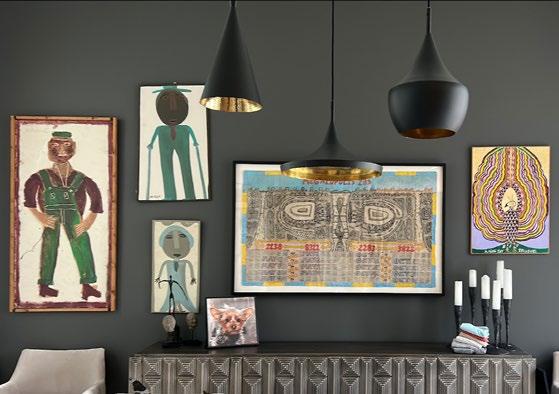
35
February 1 • April 4 • August 1 • December 5

36 THE OUTSIDER (312) 624-9487 www.art.org @intuitartcenter 756 N. Milwaukee Avenue Chicago, IL 60642 intuit@art.org











 Photos by Cheri Eisenberg, Fred Scruton and Intuit
Photos by Cheri Eisenberg, Fred Scruton and Intuit



 Rhéa Marmentini (Hungarian, b. 1979), Valencia Province Photo: December 4, 2018
Rhéa Marmentini (Hungarian, b. 1979), Valencia Province Photo: December 4, 2018






















 Georgia Blizzard (American, 1919-2002). Mediator, 1993. Clay, 8 1/2 x 7 x 6 in. Collection of Intuit: The Center for Intuitive and Outsider Art, gift of the Susann Craig Estate, 2023.1.
Photo by John Faier
Georgia Blizzard (American, 1919-2002). Mediator, 1993. Clay, 8 1/2 x 7 x 6 in. Collection of Intuit: The Center for Intuitive and Outsider Art, gift of the Susann Craig Estate, 2023.1.
Photo by John Faier













